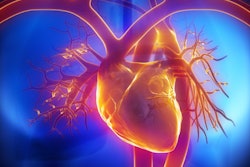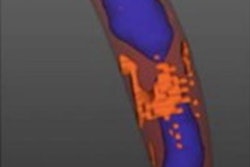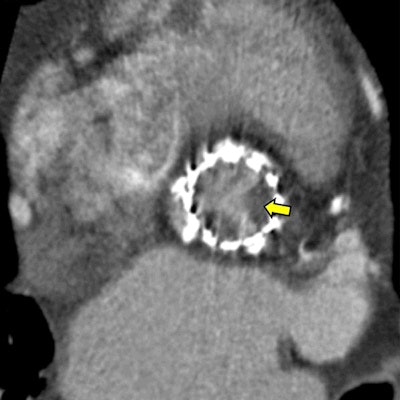
To develop new techniques and better diagnose and treat heart disease, more cardiac imaging specialists are required, and cardiologists and radiologists must collaborate more closely to achieve their common goals, according to U.K. experts.
"The model in Edinburgh is very much of cardiologists and radiologists working together, and if you can achieve that, I think you make very quick strides forward," said Dr. Marc Dweck, senior lecturer and consultant cardiologist at the University of Edinburgh, speaking in a new podcast from the British Institute of Radiology (BIR). "We need to think about mechanisms of training and working together that allow that to happen."
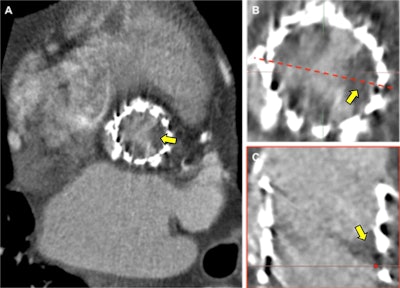 Transcatheter aortic valve replacement hypoattenuated leaflet thickening several months after transcatheter aortic valve implantation (26 mm Spaien 3, Edwards Lifesciences). Elevated transprosthesis pressure gradients were observed on echocardiography, and 4D cardiac CT was performed (A). Hypoattenuation of all three prosthesis cusps was present with a restricted excursion of the leaflets during ventricular systole (B). Laminar deposition of low attenuation material on the aortic aspect of the prosthesis results in the thickened appearance of the leaflet (C). Resolution with anticoagulation and restoration of normal leaflet motion is observed with this CT finding suggesting it may represent subacute thrombus. All images courtesy of BIR.
Transcatheter aortic valve replacement hypoattenuated leaflet thickening several months after transcatheter aortic valve implantation (26 mm Spaien 3, Edwards Lifesciences). Elevated transprosthesis pressure gradients were observed on echocardiography, and 4D cardiac CT was performed (A). Hypoattenuation of all three prosthesis cusps was present with a restricted excursion of the leaflets during ventricular systole (B). Laminar deposition of low attenuation material on the aortic aspect of the prosthesis results in the thickened appearance of the leaflet (C). Resolution with anticoagulation and restoration of normal leaflet motion is observed with this CT finding suggesting it may represent subacute thrombus. All images courtesy of BIR.In the research field, the group is looking at using precision-imaging techniques in a number of different cardiovascular diseases. For instance, with coronary artery disease, clinicians know that patients who have experienced a heart attack have a 20% chance of having another heart attack in the next five years -- despite doctors providing the best evidence-based care.
To date, imaging using invasive coronary angiography has focused on identifying the narrowing heart arteries, but most heart attacks occur in regions without any major heart narrowing.
 Dr. Alastair Moss.
Dr. Alastair Moss."We think heart attacks may actually more likely be related to disease activity inside the arterial wall," said Dr. Alastair Moss, a research fellow in cardiovascular imaging at the University of Edinburgh, whose special interests include combining advanced imaging modalities to better understand the pathophysiology of cardiovascular disease. "This is where our current research studies are focusing. We're using novel molecular imaging techniques such as PET/CT so that we can now measure disease activity inside coronary plaques."
Through the facility's PET/CT program, supported by the British Heart Foundation and Wellcome Trust, the researchers are seeking to find out whether this modality can be used to predict future heart attacks and help doctors decide who needs more aggressive treatment.
The hypothesis under investigation is: Does identifying patients with increased disease activity in the coronary arteries help identify patients at increased risk of having a heart attack? It will be one of the first multicenter PET/CT studies to investigate whether the radiotracer F-18 fluoride can be used prospectively to identify patients at risk of recurrent heart attacks, according to Dweck. He expects the results to be available in 2021.
"I think the program in Edinburgh encompasses the whole spectrum of different stages of imaging studies," said Dweck, adding that, in particular, the role of PET imaging as a research tool in cardiovascular disease excites him.
"We're interested in developing new imaging techniques, particularly on the PET side," he continued. "We've got some very exciting new tracers that we're going to be moving into humans for the first time. ... There's this pipeline of studies starting at a very basic level of first-in-human studies to see where these new imaging techniques may be used and following these all the way through to randomized controlled trials where we're actually trying to improve patient care and outcomes."
Dweck noted that several research articles will be published in the next year or so that look at the use of cardiovascular PET imaging in a lot of different conditions, such as bioprosthetic valve disease, erectile dysfunction and peripheral vessel disease. The next phase of research will seek to demonstrate the benefit of these new imaging modalities and show how they improve patient outcomes, he added.
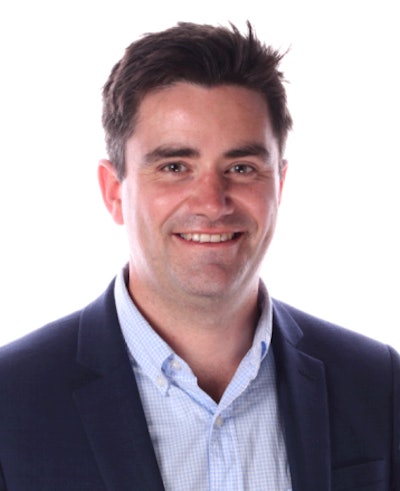 Dr. Marc Dweck.
Dr. Marc Dweck."There are a raft of these trials in the pipeline that might well lead to the widespread adoption of these new imaging techniques in the research setting and ultimately in clinical care," he said. "Of course, these approaches are expensive, and we need to carefully identify the cost-effectiveness of these studies, as well as their ability to affect outcomes. I think that is to me an exciting area of research moving forward."
Overall, now is a great time to be involved in cardiac imaging, according to Moss, who is the principal investigator of the PRE18FFIR study, a multicenter trial that aims to identify high-risk plaques in patients with recent myocardial infarction.
"There's never really a better time to be involved in cardiac imaging research, especially in the U.K., where we're often regarded by the international community as a trendsetter in this field," he said.
One reason for the U.K.'s reputation in this field is the Scottish Computed Tomography of the Heart trial (SCOT-HEART), which found coronary CT angiography (CCTA) reduces the risk of heart attack and death by 41%, Moss noted. The team unveiled the results in late August 2018.
"For clinicians in the field of cardiac imaging, this was groundbreaking as it showed that even when evidence-based practice was already in place, clinicians could significantly improve a patient's care by adopting a more precise imaging-focused approach to the classification of coronary artery disease," he commented.
Dweck predicts a slew of studies will follow SCOT-HEART. "I think the next couple of studies from SCOT-HEART will be really interesting at this point trying to work out why does CT imaging have this dramatic effect on patient outcomes?" he said.
The podcast has been produced to coincide with the International Day of Radiology on 8 November. To listen to it, visit the BIR website.




